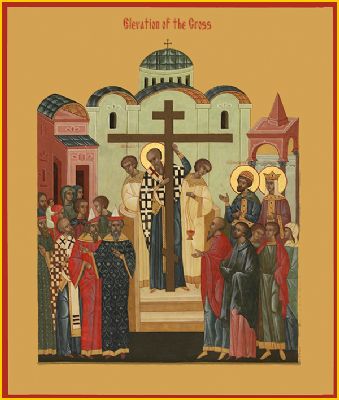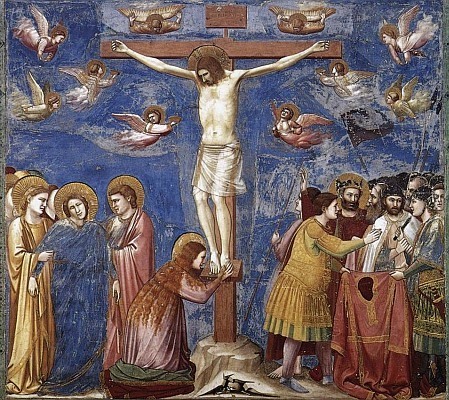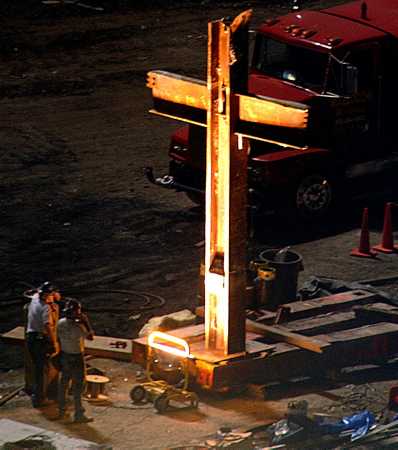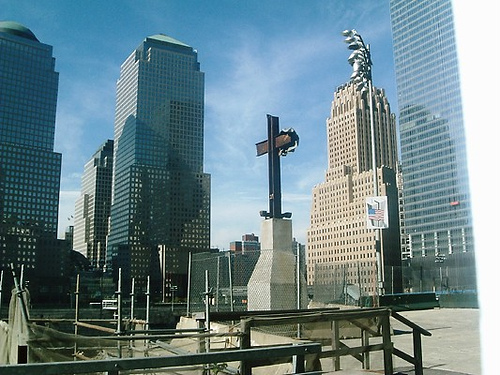|
Volume 1 No. 29 September 14, 2011
Exaltation of the Holy Cross/ Festival of the Cross Special If the Journal is not displayed properly, please click on the link below (or copy and paste) to read from webhttp://www.MalankaraWorld.com/Newsletter/MWNews_29_september-14-2011.htm |
||
|
||
Table of Contents |
||
|
September 14th is an important feast of the church. It is called
the Exaltation of the Cross (or Triumph of the Cross).
On this feast we honor the Holy Cross by which Christ redeemed the world.
The miraculous discovery of the cross on September 14, 326, by Saint
Helen, mother of Constantine, while she was on a pilgrimage to
Jerusalem, is the origin of the tradition of celebrating the Feast
of the Exaltation of the Cross on this date. Constantine later built
the Church of the Holy Sepulchre on the site of her discovery of the
cross.
Christians 'exalt' (raise on high) the Cross of Christ as the instrument of our salvation. Adoration of the Cross is, thus, adoration of Jesus Christ, the God Man, who suffered and died on this Roman instrument of torture for our redemption from sin and death. The cross represents the One Sacrifice by which Jesus, obedient even unto death, accomplished our salvation. The cross is a symbolic summary of the Passion, Crucifixion and Resurrection of Christ — all in one image.
In addition to the articles given in this Journal, we have a full featured Home Page to Commemorate Sleeba Perunnal in Malankara World. You can find it at: |
||
|
Bible Reading
For The Feast of Holy Cross (September 14)
Evening
Morning
Before Holy Qurbana
Holy Qurbana
|
||
| Inspiration for Today | ||
|
Grace, Divine Protection In his book, 'The Red Sea Rules,' pastor Rob Morgan writes, "Several years ago, I was walking down a sidewalk in East Nashville, making a pastoral visit. Suddenly I saw a German shepherd flying across a lawn, barking, snarling, teeth bared, mouth frothing. I was so startled that as it lunged at me, I screamed and jumped backward. But between me and my would-be attacker, there was a chain-link fence. The dog struck the fence full force. My heart was racing, but I was utterly safe because of the protective fence. "Satan can growl and bark, lunge and threaten. But when we're enclosed by the grace of our Lord Jesus Christ, he can do us no real or lasting harm." |
||
|
Early in the fourth century St. Helena, mother of the Roman Emperor Constantine,
went to Jerusalem in search of the holy places of Christ's life. She razed the
Temple of Aphrodite, which tradition held was built over the Savior's tomb, and
her son built the Basilica of the Holy Sepulcher over the tomb. During the
excavation, workers found three crosses. Legend has it that the one on which
Jesus died was identified when its touch healed a dying woman. The cross immediately became an object of veneration. At a Good Friday celebration in Jerusalem toward the end of the fourth century, according to an eyewitness, the wood was taken out of its silver container and placed on a table together with the inscription Pilate ordered placed above Jesus' head: Then "all the people pass through one by one; all of them bow down, touching the cross and the inscription, first with their foreheads, then with their eyes; and, after kissing the cross, they move on." To this day the Eastern Churches, Catholic and Orthodox alike, celebrate the Exaltation of the Holy Cross on the September anniversary of the basilica's dedication. The feast entered the Western calendar in the seventh century after Emperor Heraclius recovered the cross from the Persians, who had carried it off in 614, 15 years earlier. According to the story, the emperor intended to carry the cross back into Jerusalem himself, but was unable to move forward until he took off his imperial garb and became a barefoot pilgrim. The cross is today the universal image of Christian belief. Countless generations of artists have turned it into a thing of beauty to be carried in procession or worn as jewelry. To the eyes of the first Christians, it had no beauty. It stood outside too many city walls, decorated only with decaying corpses, as a threat to anyone who defied Rome's authority—including the heretic sect which refused sacrifice to Roman gods. Although believers spoke of the cross as the instrument of salvation, it seldom appeared in Christian art unless disguised as an anchor or the Chi-Rho until after Constantine's edict of toleration.
|
||
|
from The Patriarchal Journal
vol.29 – October/November 1991 – No. 108/109. Pages 463- 470
How blessed are those who are saved by the cross of our Lord Jesus, for they have obtained a godly power to overcome Satan and sin. For them natural death has become a transition from a miserable, transitory life to a glorious, eternal life. How miserable are those who are perishing for they do not know the holy sacraments, they have lost their power, and the sacraments have become nonexistent to them. Didn’t the writer of the Psalms speak about people like them, “Fools say in their hearts, There is no God. They are corrupt, they do abominable deeds; there is no one who does good” (Psalm 14:1). For the one who wallows in a pit of corruption and sin and does not comprehend the heavenly lessons is considered foolish because he has disregarded God, just as the idolaters were far away from the true God, worshiping the created and not the Creator. They are ignorant of the power of the cross, for they do not believe in God’s plan of salvation for humanity, they do not understand the secret of the work of redemption, they do not believe in the beloved Redeemer. And, concerning the Jews "if they had understood they would not have crucified the Lord of glory " (I Corinthians 2:8). For to those who were entrusted to keep the prophets, the law and the law codes, the cross became a stumbling block because they didn’t want to study the prophets to understand the secret of redemption. Therefore, they lost the power of the cross which is called the power of God by Saint Paul. The cross derives its power from the merit of Christ’s death on it and His resurrection from the dead which announced the Father’s acceptance of the atonement of the crucified One and His redemption of humanity. As the apostle Peter expressed to the chief priests of the Jews about the Lord Jesus, “The God of our ancestors raised up Jesus, whom you had killed by hanging him on a tree. God exalted him at his right hand as Leader and Savior that He might give repentance to Israel and forgiveness of sins” (Acts 5:30,31). For millions of people were crucified before Christ was crucified and after, but not one of them was raised from the dead but their names were wiped out and their souls went away and they left nothing but a memory behind. But only the Lord Jesus, who was crucified and died on the cross and was buried in a new tomb and rose from the dead on the third day, has raised us with Him and has seated us with Him in heaven. Since He was crucified for our sake and redeemed us from the curse of the law He became a curse for us as it is written, “Cursed is anyone who hangs on a tree” (Galatians 3:13 and Deuteronomy 21:23). So, Christ exchanged the curse of the cross for a spring of heavenly blessings and spiritual graces and the cross has become the banner of the Christian church, its symbol and the subject of its boasting. After it was a sign of weakness and humiliation it became a sign of the power of God and the glory of His church. This godly power is taken by everyone who believes to obtain salvation by the blood of Jesus Christ that was shed on the cross; that the blood of Christ is truly synonymous with the cross for it is the blood of the incarnate God, as the apostle Paul says to the priests of Ephesus: “Keep watch over yourselves and over all the flock of which the Holy Spirit has made you overseers, to shepherd the church of God that he obtained with his own blood” (Acts 20:28).
Read the full article in Malankara World |
||
|
Homily by HH Pope John Paul II
"The Son of Man must be lifted up" (John 3:14). Dear Brothers and Sisters, 1. On this day when I have the joy of celebrating the Eucharist with you here in Phoenix, let our first thoughts be directed to the victorious Cross of our Saviour, to the Son of Man who is lifted up! Let us adore and praise Christ, our Crucified and Risen Lord. To him, and to the Father and the Holy Spirit, be glory and thanksgiving now and forever! How good it is to join our voices in praise of God on this feast of the Triumph of the Cross. And how appropriate to celebrate the feast here in the city of Phoenix, which bears the name of an ancient symbol often depicted in Christian art to represent the meaning of the victorious Cross. The phoenix was a legendary bird that, after dying, rose again from its own ashes. Thus, it came to be a symbol of Christ who, after dying on the Cross, rose again in triumph over sin and death. We can rightly say that, by divine providence, the Church in Phoenix has been called in a particular way to live the mystery of the victory of the Cross. Certainly, the Cross of Christ has marked the progress of evangelization in this area since its beginning: from the day, three hundred years ago, when Father Eusebio Kino first brought the Gospel to Arizona. The Good News of salvation has brought forth great fruit here in Phoenix, in Tucson and throughout this whole area. The Cross is indeed the Tree of Life. 2. “The Son of Man must be lifted up” (Jo. 3: 14). Today the Church makes special reference to these words of Christ as she celebrates the feast of the Triumph of the Cross. Beyond the particular historical circumstances that contributed to the introduction of this feast in the liturgical calendar, there remain these words that Christ spoke to Nicodemus during that conversation which took place at night: "The Son of Man must be lifted up". Nicodemus, as we know, was a man who loved God’s word and who studied the word with great attention. Prompted by his hunger for the truth, by his eagerness to understand, Nicodemus came to Jesus at night to find answers to his questions and doubts. It is precisely to him, to Nicodemus, that Jesus speaks these words which still echo in a mysterious way: "The Son of Man must be lifted up, that all who believe may have eternal life in him" (Ibid. 3, 14-15). Nicodemus could not have known at this point that these words contain, in a certain sense, the summary of the whole Paschal Mystery which would crown the messianic mission of Jesus of Nazareth. When Jesus spoke of being "lifted up" he was thinking of the Cross on Calvary: being lifted up on the Cross, being lifted up by means of the Cross. Nicodemus could not have guessed this at the time. And so Christ referred to an event from the history of the Old Testament which he knew about, namely, Moses lifting up the serpent in the desert. 3. It was an unusual event that took place during Israel’s journey from Egypt to the Promised Land. This journey that lasted forty years was full of tests: the people "tested” God with their infidelity and lack of trust; in turn this provoked many tests from the Lord in order to purify Israel’s faith and deepen it. Near Mount Hor a particular test took place, which was that of the poisonous serpents. These serpents "bit the people" with the result that many of them died (Nu. 21, 6). Then Moses, ordered by the Lord, “made a bronze serpent and mounted it on a pole, and whenever anyone who had been bitten by a serpent looked at the bronze serpent, he recovered” (Ibid. 21, 9). We might ask: why such a test? The Lord had chosen Israel to be his own; he had chosen this people, in order to initiate them gradually into his plan of salvation. 4. Jesus of Nazareth explains the salvific designs of the God of the Covenant. The bronze serpent in the desert was the symbolic figure of the Crucified One. Is someone who had been bitten looked upon the serpent "lifted up" by Moses on a high pole, that person was saved. He remained alive, not because he had looked upon the serpent, but because he had believed in the power of God and his saving love. Thus when the Son of Man is lifted up on the Cross of Calvary, "all who believe will have eternal life in him" (Cfr. Jo. 3: 15). There exists then a profound analogy between that figure and this reality, between that sign of salvation and this reality of salvation contained in the Cross of Christ. The analogy becomes even more striking if we keep in mind that the salvation from physical death, caused by the poison of the serpents in the desert, came about through a serpent. Salvation from spiritual death - the death that is sin and that was caused by man - came about through a Man, through the Son of Man "lifted up" on the Cross. In this nighttime conversation, Jesus of Nazareth helps Nicodemus to discover the true sense of God’s designs. While Jesus is speaking, the fulfillment of these divine designs belongs to the future, but at this point the future is not far away Nicodemus himself will be a witness to this fulfillment. He will be a witness to the paschal events in Jerusalem. He will be a witness to the Cross, upon which the one who speaks with him this night - the Son of Man - will be lifted up.
Read the rest of the article in
Malankara World |
||
|
The cross is such an interesting thing. The tool to kill slaves becomes the
symbol of hope and salvation - it is truly for Christians a place where Heaven
and earth come together in the loving self-sacrifice of Jesus. On it, our
Emmanuel, God With Us, Jesus, stretches out his arms in a loving embrace to all
of humanity. His own blood stains the lintel of this new Passover, and God the
Father does what he did not require Abraham to go through with, the sacrifice of
his son. Timeless, this one cross becomes a beacon, a sign of foolishness to the
unbeliever but the very source of light and life to those who answer its call.
At The Foot of Your Cross Lord,
All around me are the howling winds, Like the Magdalene, Here is the only shelter I know Here, What have I to give Here, |
||
The shape was oddly identifiable in the blasted wreckage of the World Trade Center, standing upright amid beams bent like fork tines and jagged. A grief-exhausted excavator named Frank Silecchia found it on Sept. 13, 2001, two days after the terrorist attacks. A few days later, he spoke to a Franciscan priest named Father Brian Jordan, who was blessing remains at Ground Zero. “Father, you want to see God’s House?” he asked. “Look over there.” Father Brian peered through the fields of shredded metal. “What am I looking for?” he asked. Silecchia replied, “Just keep looking, Father, and see what you see.” As Father Brian stared, other rescue workers gathered around him. There was a long moment of silence as he beheld what he considered to be a sign. Against seeming insuperable odds, a 17-foot-long crossbeam, weighing at least two tons, was thrust at a vertical angle in the hellish wasteland. A cross. Silecchia said worriedly, “Father, they might put this in some dump heap.” “Frankie, no,” Father Brian said. “No, they will not.”
Instead, as the 10th anniversary of the attacks nears, the “World Trade Cross” continues to occupy a central if controversial place at Ground Zero. Shortly after its discovery, Father Brian persuaded city officials to allow a crew of volunteer union laborers to lift it out of the wreckage by crane and mount it on a concrete pedestal. They placed it in a quiet part of the site, on Church Street, where on Oct. 3, 2001, Father Brian blessed it with the prayer of St. Bonaventure. “May it ever compass Thee, seek Thee, find Thee, run to Thee, attain Thee, meditate upon Thee, speak of Thee, and do all things to the praise and glory of Thy name ---" When he finished, the crane operators sounded their horns, a choral blast. Each week, Father Brian held services there. He became the chaplain of the hard hats. Whenever crews working to find the dead needed a blessing or a prayer or absolution, Father Brian would offer it. Sometimes victims’ families came to pray. The congregations grew from 25 or 35 to 200 and 300. Men cut replicas of the cross out of ruined steel and carried them in their pockets. In July, the nonprofit group American Atheists sued to remove it, calling it an unlawful and “repugnant” attempt to promote religion on public land. One group member told ABC News that it was “an ugly piece of wreckage” that connoted only “horror and death.” To which Father Brian sighs heavily. There were T-beams on every floor of the World Trade center buildings. If we are to remove from public life every object resembling a cross, he says, we have our work cut out. We can start, he suggests, “with telephone poles.” "The cross is a perfect example. That was an artifact that was literally born from the site, and it played an actual role during that hellish recovery period.” For 10 months, Father Brian conducted services there every Sunday. He performed a windy, freezing midnight Christmas Mass, with the Host flying off the plate. He performed a Mother’s Day Mass, a Father’s Day Mass.
Once again, Father Brian blessed it. By this time, it had acquired a steel plaque, affixed by a welder. “The Cross at Ground Zero — founded September 13, 2001; Blessed October 4, 2001; Temporarily relocated October 15, 2006; Will return to WTC Museum, a sign of comfort for all.” *Today's devotion are excerpts taken from an article by Sally Jenkins published in the Washington Post, September 8, 2011. The entire article is available by clicking here. Prayer: Father thank you for the cross that is clearly the most recognizable symbol of what Jesus did when he gave his life for me. In the name of the Lord Jesus Christ. Amen!
Source: Christ Centered Devotion, Volume 12 Number 182, September 13, 2011 |
||
| More articles, Homilies, scripture reading, prayers and poems for the Feast of the Cross (Sleeba) are at the Malankara World Sleeba Feast Special | ||
|
http://www.MalankaraWorld.com/Library/default.htm
Malankara World Journal Subscription If you are not receiving Malankara World Journal directly, you may sign up to receive it via email free of cost. Please click here: http://www.MalankaraWorld.com/Library/Register/news_regn.asp You can contact us via email at mail@malankaraworld.com Malankara World Journal Archives Previous Issues of Malankara World Journal can be read from the archives here. You can contact us via email at mail@malankaraworld.com Thank you for your help and support. |
||
|
Malankara World Journal is published by MalankaraWorld.com
http://www.MalankaraWorld.com/
Copyright © 2011 Malankara World. All Rights Reserved. |




